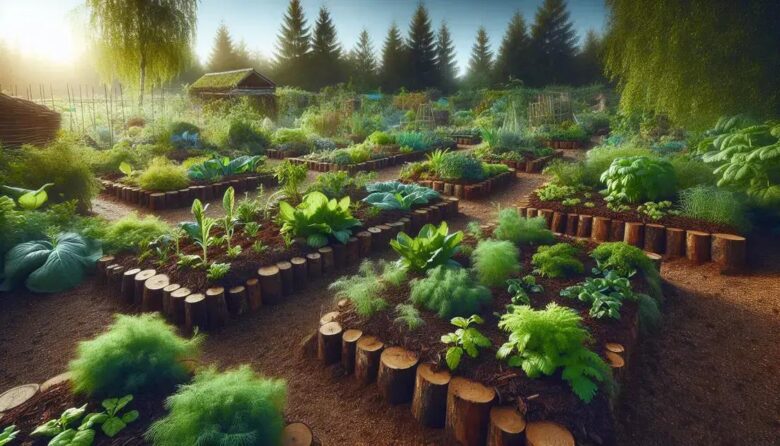Forest mulch in permaculture raised beds boosts soil fertility by retaining moisture, suppressing weeds, and enhancing nutrient-rich soil conditions, leading to healthier and more sustainable plant growth.
Forest mulch is a fantastic way to boost your garden’s health in permaculture raised beds. Ever wondered how nature itself builds soil? By mimicking the forest floor’s organic layers, you can enhance soil fertility naturally. Curious to try it in your garden?
Understanding forest mulch in sustainable permaculture
Forest mulch is an essential component of sustainable permaculture, playing a crucial role in maintaining soil health and promoting biodiversity. It mirrors the natural processes of a forest floor where layers of decaying leaves and organic matter decompose, enriching the soil with nutrients. By using forest mulch, gardeners can replicate these natural conditions in their permaculture practices.
One of the main benefits of forest mulch is its ability to retain moisture. During hot weather, it acts as a protective cover, reducing water evaporation and keeping the soil cool, which is vital for the survival of plants. Additionally, mulch suppresses weeds by blocking sunlight, which reduces competition for nutrients. As the mulch breaks down, it adds organic material back into the soil, improving soil structure and fertility.
Moreover, forest mulch provides a habitat for beneficial organisms. Earthworms, insects, and microorganisms thrive under the mulch, breaking down the organic matter and releasing rich nutrients into the soil. This symbiotic relationship enhances the ecosystem, supporting plant growth naturally and sustainably.
Benefits of using mulch in raised bed gardening
Using mulch in raised bed gardening offers numerous benefits that can transform your garden into a thriving ecosystem. One primary advantage is moisture retention. Mulch acts as a barrier, reducing water evaporation and keeping the soil moist for longer periods, which is crucial during dry spells. This means less frequent watering and more consistent plant growth.
Another significant benefit is weed suppression. By covering the soil, mulch blocks sunlight, preventing weeds from germinating and growing. This reduces the need for chemical weed killers and labor-intensive weeding, allowing for a more natural and sustainable garden management approach.
Mulch also contributes to temperature regulation. It insulates the soil, keeping it cooler in the summer and warmer in the winter, thus providing a stable environment for plant roots. This temperature regulation promotes healthier plant development and can extend the growing season.
Additionally, as mulch breaks down, it enriches the soil with organic matter, enhancing soil structure and fertility. This process creates a rich environment full of nutrients, beneficial for plant health and productivity.
Overall, using mulch in raised bed gardening supports a healthy micro-ecosystem, encouraging beneficial insects and microorganisms that further improve soil health. It’s a simple yet effective way to boost your garden’s vitality and resilience.
Step-by-step guide to applying forest mulch
Applying forest mulch to your garden beds can significantly enhance soil health and plant growth. Here is a step-by-step guide to help you apply forest mulch effectively. First, clear any existing weeds or debris from the garden area to ensure the mulch can lay flat and do its job efficiently.
Next, water the soil thoroughly. Moist soil is crucial before applying mulch because it helps retain moisture effectively. Once the soil is prepared, spread a layer of mulch about 2-4 inches thick. Make sure not to pile mulch directly against plant stems to avoid rot and encourage healthy growth.
Additionally, leave some space around tree trunks and plant bases for air circulation. This prevents fungal growth and ensures that the mulch does not impede plant development. Over time, as you notice the mulch breaking down, replenish it to maintain the desired thickness for continued benefits.
Finally, observe the impact of mulch on your plants and soil. If you see improvements in soil moisture retention and reduced weed growth, you’ve applied it correctly. Adjust the mulch layer as needed to maintain optimal conditions for your plants.
Common materials used for effective mulch
To create effective mulch for your garden, consider using a variety of common materials that offer different benefits. Organic materials are the most popular choice due to their ability to decompose and enrich soil health. Leaf mold, for instance, is excellent for moisture retention and adds humus as it breaks down. It’s a simple yet highly efficient choice, especially if you gather fallen leaves.
Wood chips are another excellent option. They provide long-lasting coverage and slow nutrient release, ideal for perennial beds. When opting for wood chips, ensure they are from untreated wood to avoid harmful chemicals leaching into the soil.
For more immediate soil enrichment, grass clippings are readily available. They decompose quickly, releasing nitrogen, which is vital for plant growth. Just be sure to spread them thinly to prevent matting and odor.
Straw is favored for vegetable gardens. It offers good weed suppression and insulation. However, ensure it’s free from seeds to avoid unintentional sprouting. Another beneficial material is compost. It’s nutrient-rich and improves soil structure, promoting a lush garden environment.
Experimenting with different mulch materials can help identify what works best for your specific gardening needs, each enhancing soil life and health in its own unique way.
How mulch supports soil building and fertility
Mulch plays a vital role in supporting soil building and enhancing soil fertility. It covers the soil surface, protecting it from erosion and helping maintain a stable structure. As the mulch breaks down, it adds organic matter to the soil, improving its texture and aeration. This process encourages the development of rich humus, which holds nutrients and moisture, making them more accessible to plant roots.
Another significant benefit of using mulch is its ability to enhance microbial activity in the soil. Mulch creates a conducive environment for earthworms and microorganisms, which are essential for decomposing organic matter. This decomposition process releases nutrients back into the soil, like nitrogen, phosphorus, and potassium, which are crucial for plant health and growth.
The insulating properties of mulch help regulate soil temperatures, preventing extreme fluctuations that can harm plant roots. This stable environment promotes resilient root systems and stimulates active soil life, leading to a more robust plant development. Moreover, by preventing weed growth, mulch ensures that nutrients are not being competed for, leaving more available for your plants.
Overall, consistent use of mulch enhances soil fertility by transforming it into a nutrient-dense medium, vital for a healthy and productive garden.
Best practices for maintaining mulched raised beds
Maintaining mulched raised beds is essential for long-lasting benefits in your garden. Start by ensuring the mulch layer remains at an optimal thickness of 2-4 inches. This helps with moisture retention and weed suppression. Check regularly to see if it has decomposed, and add more as needed to keep the layer intact.
During the growing season, monitor the soil moisture under the mulch. While mulch retains water, raised beds can dry out more quickly. Ensure that plants receive adequate water, especially during dry spells. Moisture meters can be useful for checking hydration levels without disturbing the mulch layer too much.
Weed control is another key aspect. Although mulch reduces weed growth, some persistent weeds might still emerge. Remove these by hand to prevent them from competing for nutrients. Avoid using chemical weed killers as they can disrupt the ecosystem balance.
Fertilize occasionally, but choose organic options to work harmoniously with the mulch’s natural processes. Compost tea or well-rotted manure can complement the nutrient release from decomposing mulch. Additionally, rotating crops annually in the beds can help prevent soil nutrient depletion.
Lastly, keep an eye on pests. While mulch can harbor beneficial insects, it might also attract pests. Inspect plants regularly and use natural pest control methods, like introducing predator insects, to maintain a healthy garden ecosystem.
Summing Up the Magic of Forest Mulch in Gardening
Implementing forest mulch in your permaculture raised beds brings countless benefits that can’t be overlooked. From moisture retention and soil building to enhancing fertility, mulch turns your garden into a sustainable ecosystem. By following best practices, such as maintaining the right mulch thickness and monitoring moisture, gardeners can maximize these benefits.
Whether you are leveraging mulch for its temperature regulation or nutrient release, consistent attention and care in application will reward you with vibrant, thriving plants. Not only does mulch suppress weeds naturally, but it also encourages a healthy biodiversity within your garden.
Incorporating these simple yet powerful techniques can significantly impact your gardening success. Forest mulch creates a supportive environment for plant growth, ensuring your garden is both productive and eco-friendly. Discover the magic of forest mulch and transform your gardening experience today!
FAQ – Common Questions About Using Forest Mulch in Gardening
What is the primary benefit of using forest mulch in raised beds?
Forest mulch helps retain moisture, suppress weeds, and enrich the soil with organic matter for healthier plant growth.
How often should I add mulch to my raised beds?
You should monitor the mulch layer periodically and add more when it has decomposed to maintain a thickness of 2-4 inches.
Can mulch introduce pests into my garden?
Mulch can sometimes attract pests, so it’s important to monitor your garden and use natural pest control methods if needed.
Is there a specific type of mulch that’s best for vegetable gardens?
Straw is often favored for vegetable gardens as it provides good weed suppression and insulates the soil without introducing weed seeds.
How does mulch support soil fertility?
As mulch breaks down, it adds organic material to the soil, enhances microbial activity, and releases essential nutrients like nitrogen.
Can I use grass clippings as mulch?
Yes, grass clippings are a great option as they decompose quickly and release nitrogen, but ensure they are spread thinly to avoid matting.



